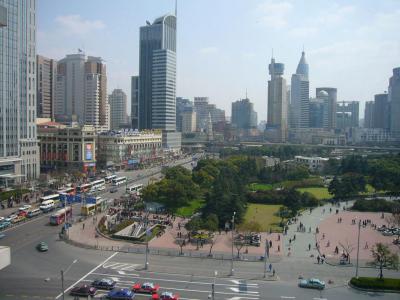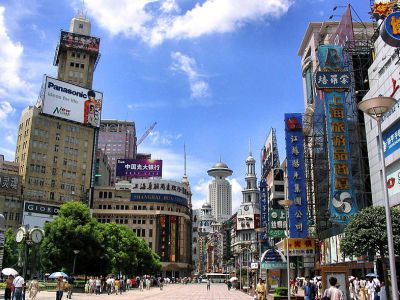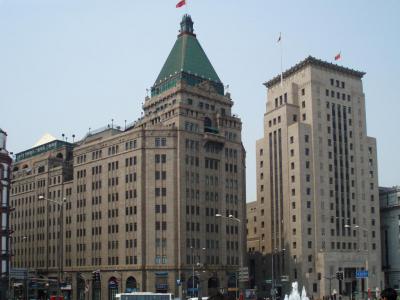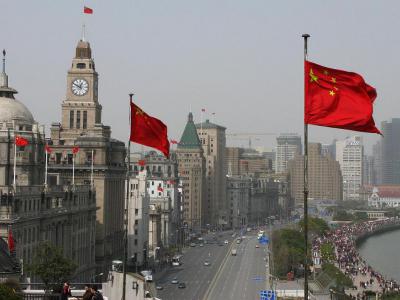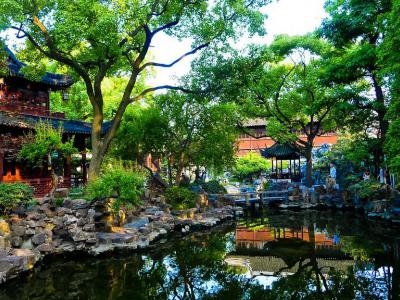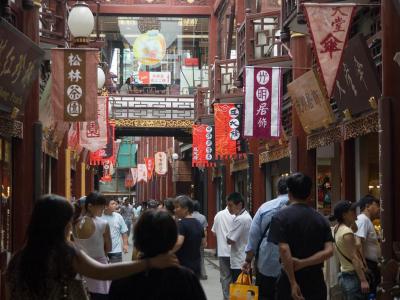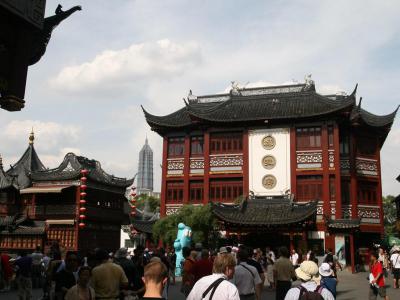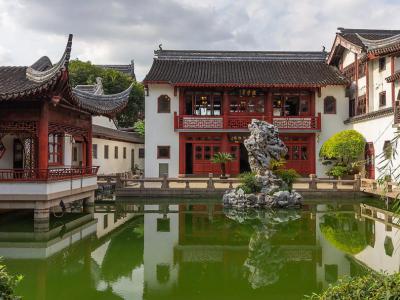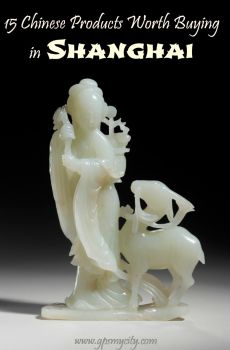
Shanghai Introduction Walking Tour (Self Guided), Shanghai
Perhaps more than any other Chinese city, Shanghai deserves to be called the “face of modern China.” Despite modern look, the city emerged on a map as far back as 751 AD. Shanghai County was established under the Yuan Dynasty in the 13th century, although the city character, as we know it today, began to take shape in the aftermath of the first Opium War in 1842. The post-war treaty opened Shanghai to international trade, bringing the influx of cosmopolitan adventurers from around the world searching for easy fortune. And they sure found it in Shanghai, prompting the city's rapid development to the glamorous shine still visible today in the opulent facades along the famous Bund and the downtown area.
That flow of migrants entailed a construction boom, leaving mark on Shanghai's architectural scape. The eclectic, vibrant mix of colonial, Art Deco, and postmodern influences has made Shanghai an architectural wonder equally appreciated by both idle wanderers and cultured professionals.
Over the years, Shanghai has evoked many associations and labels, such as “Paris of the East”, “Paradise of Adventurers”, “Queen of Eastern Settlements”, “New York of the Far East”, “City of Palaces”, and “Yellow Babylon of the Far East”, to mention but a few. Each nickname has some truth to it, reflecting the city's outstanding trading location at the mouth of the Yangtze River.
Centuries on, trade remains as important to Shanghai as ever, particularly now that the city undertakes one of the most daring development programs the world has ever known. The economic rise of China since the mid-1990s, echoing the construction boom of the 1930s, has refreshed the city skyline with thousands of brand-new high-risers and some of the world’s tallest skyscrapers, such as the Shanghai Tower, the World Financial Center, and the Jinmao Tower. Shanghai's fondness of high-rising projects doesn't stop here and has hundreds more in the planning.
This self-guided introductory walking tour of Shanghai takes you to some of the glitziest as well as traditional spots in the city, starting with The People's Square, passing by the famous Bund promenade, the lovely traditional Yuyuan Garden, and culminating with the timeless Shanghai Confucian Temple.
That flow of migrants entailed a construction boom, leaving mark on Shanghai's architectural scape. The eclectic, vibrant mix of colonial, Art Deco, and postmodern influences has made Shanghai an architectural wonder equally appreciated by both idle wanderers and cultured professionals.
Over the years, Shanghai has evoked many associations and labels, such as “Paris of the East”, “Paradise of Adventurers”, “Queen of Eastern Settlements”, “New York of the Far East”, “City of Palaces”, and “Yellow Babylon of the Far East”, to mention but a few. Each nickname has some truth to it, reflecting the city's outstanding trading location at the mouth of the Yangtze River.
Centuries on, trade remains as important to Shanghai as ever, particularly now that the city undertakes one of the most daring development programs the world has ever known. The economic rise of China since the mid-1990s, echoing the construction boom of the 1930s, has refreshed the city skyline with thousands of brand-new high-risers and some of the world’s tallest skyscrapers, such as the Shanghai Tower, the World Financial Center, and the Jinmao Tower. Shanghai's fondness of high-rising projects doesn't stop here and has hundreds more in the planning.
This self-guided introductory walking tour of Shanghai takes you to some of the glitziest as well as traditional spots in the city, starting with The People's Square, passing by the famous Bund promenade, the lovely traditional Yuyuan Garden, and culminating with the timeless Shanghai Confucian Temple.
How it works: Download the app "GPSmyCity: Walks in 1K+ Cities" from Apple App Store or Google Play Store to your mobile phone or tablet. The app turns your mobile device into a personal tour guide and its built-in GPS navigation functions guide you from one tour stop to next. The app works offline, so no data plan is needed when traveling abroad.
Shanghai Introduction Walking Tour Map
Guide Name: Shanghai Introduction Walking Tour
Guide Location: China » Shanghai (See other walking tours in Shanghai)
Guide Type: Self-guided Walking Tour (Sightseeing)
# of Attractions: 8
Tour Duration: 3 Hour(s)
Travel Distance: 6.2 Km or 3.9 Miles
Author: emma
Sight(s) Featured in This Guide:
Guide Location: China » Shanghai (See other walking tours in Shanghai)
Guide Type: Self-guided Walking Tour (Sightseeing)
# of Attractions: 8
Tour Duration: 3 Hour(s)
Travel Distance: 6.2 Km or 3.9 Miles
Author: emma
Sight(s) Featured in This Guide:
- People's Square and Park
- Nanjing Lu (Nanjing Road)
- Peace Hotel
- The Bund (Waitan)
- Yuyuan Garden
- Yuyuan Bazaar
- Shanghai Town God's Temple
- Shanghai Confucian Temple
1) People's Square and Park (must see)
People's Square, situated at the very center of Shanghai, serves as a prominent location in the city. It features world-class museums, the Grand Theater, luxurious five-star hotels, a large water fountain, and the imposing Shanghai City Hall. These structures were constructed in the late 1990s and each of them serves as a significant architectural representation of Shanghai's economic and cultural advancement.
This area stands out in China due to its exceptional collection of remarkable attractions and stunning skyline, making it a highly popular meeting place and a venue for various celebrations. Today, there are few visual reminders of People's Square's history as Asia's finest racecourse, where wealthy individuals once watched horse races. During the wartime Japanese administration, the racetrack was utilized as a detention facility, and after World War II, the Chinese nationalist government transformed it into a sports arena.
By 1952, the new Communist regime had abolished horse racing and gambling, and a section of the racetrack was converted into a recreational space, now referred to as People's Park. Both the square and the park are meticulously maintained and offer numerous benches for relaxation. The park boasts pleasant landscaping, with tree-lined pathways and ponds that are beloved by locals who often visit for leisurely walks, exercise, kite flying, and where children can enjoy various activities at the playground.
Tip:
Underneath the park, there's a fantastic underground labyrinth of galleries with colorful stores, a subway station, and a food court. A definite must-visit!
This area stands out in China due to its exceptional collection of remarkable attractions and stunning skyline, making it a highly popular meeting place and a venue for various celebrations. Today, there are few visual reminders of People's Square's history as Asia's finest racecourse, where wealthy individuals once watched horse races. During the wartime Japanese administration, the racetrack was utilized as a detention facility, and after World War II, the Chinese nationalist government transformed it into a sports arena.
By 1952, the new Communist regime had abolished horse racing and gambling, and a section of the racetrack was converted into a recreational space, now referred to as People's Park. Both the square and the park are meticulously maintained and offer numerous benches for relaxation. The park boasts pleasant landscaping, with tree-lined pathways and ponds that are beloved by locals who often visit for leisurely walks, exercise, kite flying, and where children can enjoy various activities at the playground.
Tip:
Underneath the park, there's a fantastic underground labyrinth of galleries with colorful stores, a subway station, and a food court. A definite must-visit!
2) Nanjing Lu (Nanjing Road) (must see)
Nanjing Road in Shanghai has long been the city's top shopping destination, attracting more than a million visitors daily. This famous street is divided into two sections: Nanjing East Road and Nanjing West Road. In total, they stretch for nearly 10 kilometers (about 6 miles), making it the world's longest and busiest pedestrian thoroughfare.
Nanjing East Road has held the reputation of being a shopper's paradise since the 1950s or even earlier. Its main attraction is the Shanghai No. 1 Department Store, famous for its eye-catching window displays. Some say it's a great place to browse, but not necessarily the best for finding bargains.
Once the sun sets, Nanjing East Road becomes especially lively, with various malls competing for shoppers' attention through elaborate lighting and countless advertising screens. It seems like they spare no expense when it comes to electricity bills.
Many of the buildings along this road have been standing for over a century, showcasing a unique fusion of Eastern and Western architectural styles that first gained prominence in the 1930s, establishing Shanghai as a significant intermediary between the two civilizations. The newer malls cater to the modern tastes of China's millennials, who are keen on luxury brands.
Unlike other parts of Shanghai, you won't find street vendors or markets on Nanjing Road. Everything here is on a grand scale, including Starbucks. The Starbucks Reserve Roastery, which happens to be the world's largest outlet, spans three floors and serves up to 7,000 customers a day, with seating for up to 1,000 people at once.
Tip:
For ease of travel, mini-trains run up and down half the length of Nanjing Road during day hours – convenient for those wanting to see the area, especially if tired of walking or with kids in tow.
On a foodie note, try the food court in the New World City Plaza. Huge, pretty, and clean, with numerous stores, and good prices. And the LEGO shop on its ground floor is a haven for LEGO lovers.
Nanjing East Road has held the reputation of being a shopper's paradise since the 1950s or even earlier. Its main attraction is the Shanghai No. 1 Department Store, famous for its eye-catching window displays. Some say it's a great place to browse, but not necessarily the best for finding bargains.
Once the sun sets, Nanjing East Road becomes especially lively, with various malls competing for shoppers' attention through elaborate lighting and countless advertising screens. It seems like they spare no expense when it comes to electricity bills.
Many of the buildings along this road have been standing for over a century, showcasing a unique fusion of Eastern and Western architectural styles that first gained prominence in the 1930s, establishing Shanghai as a significant intermediary between the two civilizations. The newer malls cater to the modern tastes of China's millennials, who are keen on luxury brands.
Unlike other parts of Shanghai, you won't find street vendors or markets on Nanjing Road. Everything here is on a grand scale, including Starbucks. The Starbucks Reserve Roastery, which happens to be the world's largest outlet, spans three floors and serves up to 7,000 customers a day, with seating for up to 1,000 people at once.
Tip:
For ease of travel, mini-trains run up and down half the length of Nanjing Road during day hours – convenient for those wanting to see the area, especially if tired of walking or with kids in tow.
On a foodie note, try the food court in the New World City Plaza. Huge, pretty, and clean, with numerous stores, and good prices. And the LEGO shop on its ground floor is a haven for LEGO lovers.
3) Peace Hotel (must see)
Standing proudly at the eastern end of Nanjing Road is the renowned Fairmont Peace Hotel, an iconic structure on the Bund. Originally known as the Cathay Hotel, it was inaugurated in 1929 and boasts a striking Art Deco exterior and an iconic green copper dome, both of which have recently been meticulously restored to their former splendor.
Dubbed the "Claridges of the Far East," this spot was a pre-war Shanghai hotspot, hosting celebrities like Douglas Fairbanks, Charlie Chaplin, and George Bernard Shaw. It's even rumored that Noel Coward penned "Private Lives" here in just four days while battling the flu. Owned by opium tycoon Sir Victor Sassoon, the hotel hosted many dignitaries and diplomats. It was known for its pioneering amenities, including in-room telephones, which outpaced European hotels at the time. With six floors and 120 guest rooms, it was also the first hotel in Shanghai to feature two elevators. The lavish offerings extended to private plumbing systems, marble baths with silver fixtures and enamel-coated lavatories imported from Britain.
Today, in addition to catering to upscale clientele, the hotel also draws history and architecture enthusiasts. Its Art Deco lobby, on-site Peace Museum, and the Old Shanghai reading room filled with a diverse collection of memorabilia, including Qing-period porcelain and bronze items, black-and-white photographs of days gone by, silverware, and an array of books, are notable attractions.
The ground floor café provides an excellent vantage point for people-watching from window-side seats. Meanwhile, the rooftop bar on the 9th floor offers a pleasant spot for evening drinks with a captivating view of the illuminated Bund and Pudong skyline. If you're in the mood for some leisurely classical jazz and the opportunity to enjoy a cocktail while listening to nostalgic tunes performed by a spirited group of octogenarians, make your way to the hotel's Jazz Bar, reminiscent of the 1920s and 30s, featuring the Old Jazz Band. A quality experience is virtually guaranteed!
Tip:
Those who want to take a guided tour can book it either at the hotel's museum or online. Some tours are offered in English and come at a charge.
Dubbed the "Claridges of the Far East," this spot was a pre-war Shanghai hotspot, hosting celebrities like Douglas Fairbanks, Charlie Chaplin, and George Bernard Shaw. It's even rumored that Noel Coward penned "Private Lives" here in just four days while battling the flu. Owned by opium tycoon Sir Victor Sassoon, the hotel hosted many dignitaries and diplomats. It was known for its pioneering amenities, including in-room telephones, which outpaced European hotels at the time. With six floors and 120 guest rooms, it was also the first hotel in Shanghai to feature two elevators. The lavish offerings extended to private plumbing systems, marble baths with silver fixtures and enamel-coated lavatories imported from Britain.
Today, in addition to catering to upscale clientele, the hotel also draws history and architecture enthusiasts. Its Art Deco lobby, on-site Peace Museum, and the Old Shanghai reading room filled with a diverse collection of memorabilia, including Qing-period porcelain and bronze items, black-and-white photographs of days gone by, silverware, and an array of books, are notable attractions.
The ground floor café provides an excellent vantage point for people-watching from window-side seats. Meanwhile, the rooftop bar on the 9th floor offers a pleasant spot for evening drinks with a captivating view of the illuminated Bund and Pudong skyline. If you're in the mood for some leisurely classical jazz and the opportunity to enjoy a cocktail while listening to nostalgic tunes performed by a spirited group of octogenarians, make your way to the hotel's Jazz Bar, reminiscent of the 1920s and 30s, featuring the Old Jazz Band. A quality experience is virtually guaranteed!
Tip:
Those who want to take a guided tour can book it either at the hotel's museum or online. Some tours are offered in English and come at a charge.
4) The Bund (Waitan) (must see)
If you want to explore the history of Shanghai as the leading financial hub of modern China, The Bund is the ideal place to start. Initially serving as a path for towing rice-loaded barges, it eventually became the site of Shanghai's first foreign settlement, evolving into a bustling business district where major banks and trading companies established their presence to take advantage of the emerging trading opportunities.
In its heyday, The Bund also hosted the Russian and British consulates, as well as the English club and the Masonic lodge. Prior to the communist victory in the Chinese Civil War, the area featured numerous statues of notable colonial and European figures. These have since been replaced by a bronze statue of Chen Yi (Shanghai's first mayor after the communist takeover) and a Monument to the People’s Heroes at the northern end.
During the 1990s, The Bund underwent restoration, showcasing a waterfront adorned with a variety of buildings representing the architectural styles of nations that once sought to be involved in Shanghai's development.
The western section of The Bund boasts older colonial-style architecture, prominently featuring the neo-classical Hong-Kong and Shanghai Banking Corporation building and the Signal Tower, formerly maintained by the Jesuits to aid local shipping. For many locals, this area serves as a reminder of a century of foreign dominance. In the present golden age, however, it has transformed into a vibrant hub for top-notch dining, entertainment, and shopping.
Set against the backdrop of the now-famous Shanghai skyline, adorned with iconic skyscrapers of various shapes, heights, and colors, The Bund is particularly breathtaking after sunset when all the lights illuminate the area. Be sure to visit before 10pm, as some of the lights are turned off after that time.
Tip:
If you're out taking a stroll along The Bund, make way to the high-ground part beside the river for a better look at the two sides of the promenade. Otherwise, climb to the observation deck of one of the high towers to the east of the Huangpu River and see the whole stretch of the riverfront from up there. A sight not to be missed!
In its heyday, The Bund also hosted the Russian and British consulates, as well as the English club and the Masonic lodge. Prior to the communist victory in the Chinese Civil War, the area featured numerous statues of notable colonial and European figures. These have since been replaced by a bronze statue of Chen Yi (Shanghai's first mayor after the communist takeover) and a Monument to the People’s Heroes at the northern end.
During the 1990s, The Bund underwent restoration, showcasing a waterfront adorned with a variety of buildings representing the architectural styles of nations that once sought to be involved in Shanghai's development.
The western section of The Bund boasts older colonial-style architecture, prominently featuring the neo-classical Hong-Kong and Shanghai Banking Corporation building and the Signal Tower, formerly maintained by the Jesuits to aid local shipping. For many locals, this area serves as a reminder of a century of foreign dominance. In the present golden age, however, it has transformed into a vibrant hub for top-notch dining, entertainment, and shopping.
Set against the backdrop of the now-famous Shanghai skyline, adorned with iconic skyscrapers of various shapes, heights, and colors, The Bund is particularly breathtaking after sunset when all the lights illuminate the area. Be sure to visit before 10pm, as some of the lights are turned off after that time.
Tip:
If you're out taking a stroll along The Bund, make way to the high-ground part beside the river for a better look at the two sides of the promenade. Otherwise, climb to the observation deck of one of the high towers to the east of the Huangpu River and see the whole stretch of the riverfront from up there. A sight not to be missed!
5) Yuyuan Garden (must see)
This lovely classical Chinese garden was built in 1577, under the Ming Dynasty, by a high-ranking imperial court official who dedicated it to his elderly father, and quite fittingly so, as ‘yu’ means peace and comfort in Chinese. Probably because of this name or good luck, despite changing fortunes, the garden had miraculously survived the passage of centuries and was reopened to the public in 1961.
For those unfamiliar with Chinese gardening, this would be a great introduction to its elegance manifested, among other things, in the hidden bat and dragon features and, in this particular case, a huge authentic rockery dating back to the Ming period. Overall, the garden has less emphasis on flora and more on water and the harmonious position of elements.
It may well look small, but you will be amazed at how much actually fits in here. The corridors, archways and zigzag bridges all are carefully placed with a great deal of meaning. Of special interest is the Ming-style rosewood furniture in three halls within the garden, one of which is historically famous as the headquarters of the anti-imperialist “Little Sword” society during the Taiping uprising in the 1850s-60s. The roofs and tops of the walls here are decorated with incredible carvings of dragons, horses, and warriors.
Among other highlights is the famous Jade Rock, a 5-ton boulder said to have been one of the private collection items of the Song Dynasty Emperor Huizong. Interestingly enough, this rock's 72 holes are reportedly positioned so as to make the water or smoke sent into one of the holes, come out from all the other holes simultaneously. Sometimes, the guides show another trick with a coin dropped into a hole at the top and exiting from a certain hole down below (each time different) in accordance, they say, with the person's astrological sign.
Tip:
Depending on the time of your visit, the garden may be quite crowded – but that's China! Try coming early, as closer to the opening hours as possible; otherwise, later in the day, the queues are usually long! Don't forget a bottle of water or check out a two-storey teahouse on the island in the middle of the garden. The Queen of England herself once dropped in for a cup of tea there, so these days it’s a bit pricey, but you’re welcome to poke about anyway.
For those unfamiliar with Chinese gardening, this would be a great introduction to its elegance manifested, among other things, in the hidden bat and dragon features and, in this particular case, a huge authentic rockery dating back to the Ming period. Overall, the garden has less emphasis on flora and more on water and the harmonious position of elements.
It may well look small, but you will be amazed at how much actually fits in here. The corridors, archways and zigzag bridges all are carefully placed with a great deal of meaning. Of special interest is the Ming-style rosewood furniture in three halls within the garden, one of which is historically famous as the headquarters of the anti-imperialist “Little Sword” society during the Taiping uprising in the 1850s-60s. The roofs and tops of the walls here are decorated with incredible carvings of dragons, horses, and warriors.
Among other highlights is the famous Jade Rock, a 5-ton boulder said to have been one of the private collection items of the Song Dynasty Emperor Huizong. Interestingly enough, this rock's 72 holes are reportedly positioned so as to make the water or smoke sent into one of the holes, come out from all the other holes simultaneously. Sometimes, the guides show another trick with a coin dropped into a hole at the top and exiting from a certain hole down below (each time different) in accordance, they say, with the person's astrological sign.
Tip:
Depending on the time of your visit, the garden may be quite crowded – but that's China! Try coming early, as closer to the opening hours as possible; otherwise, later in the day, the queues are usually long! Don't forget a bottle of water or check out a two-storey teahouse on the island in the middle of the garden. The Queen of England herself once dropped in for a cup of tea there, so these days it’s a bit pricey, but you’re welcome to poke about anyway.
6) Yuyuan Bazaar (must see)
Regularly packed with locals and tourists, this busy shopping area – located just outside the famous Yuyuan Gardens – is a good chance to get a glimpse of Shanghai's everyday life. Amid the plethora of goods on sale – including fresh produce, second-hand stuff, antiques and handicrafts – the most intriguing, perhaps, are the countless food offerings whose vendors seemingly compete with each other. The vast majority of them specialize in dumplings of every imaginable filling; they even have dumplings filled with soup and served with a straw. The Nanxiang Shanghai steamed buns are pretty good on a chilly day either, and there's a long but well-organized queue for them in the central courtyard.
On the whole, this new-looking Ming-style bazaar is a cacophony of shops, street performers, sedan-chair rides and swarms of people everywhere. It covers an area of over 50 hectares and houses almost 3,000 shops and nearly 10,000 vendors. Among them are souvenir shops with tonnes of fine gift ideas, from painted snuff bottles and delightful Chinese kites to embroidered and clever palm-and-finger paintings.
As with any shopping in Asia, haggling skills are quite handy here, especially if you've done your homework on products and prices previously. Another good thing is to buy as the locals buy, particularly women, who certainly know where the best deals are.
Why You Should Visit:
No matter how commercialized, this is still a pretty sight to behold. Only in China!
Tip:
Other than the bazaar itself, there are a few spots just behind the Yuyan Gardens on Fuyou Street where you can find things at wholesale prices. In particular, if you're after household items, check out the Fuyou Street Merchandise Mart – similar to WalMart in the U.S., but in a fraction of the space it usually occupies there. Bargaining here is recommended, but the prices aren’t too high to begin with – just perfect for those on a budget.
On the whole, this new-looking Ming-style bazaar is a cacophony of shops, street performers, sedan-chair rides and swarms of people everywhere. It covers an area of over 50 hectares and houses almost 3,000 shops and nearly 10,000 vendors. Among them are souvenir shops with tonnes of fine gift ideas, from painted snuff bottles and delightful Chinese kites to embroidered and clever palm-and-finger paintings.
As with any shopping in Asia, haggling skills are quite handy here, especially if you've done your homework on products and prices previously. Another good thing is to buy as the locals buy, particularly women, who certainly know where the best deals are.
Why You Should Visit:
No matter how commercialized, this is still a pretty sight to behold. Only in China!
Tip:
Other than the bazaar itself, there are a few spots just behind the Yuyan Gardens on Fuyou Street where you can find things at wholesale prices. In particular, if you're after household items, check out the Fuyou Street Merchandise Mart – similar to WalMart in the U.S., but in a fraction of the space it usually occupies there. Bargaining here is recommended, but the prices aren’t too high to begin with – just perfect for those on a budget.
7) Shanghai Town God's Temple (must see)
Traditionally, any notable city in China with a sense of history has a temple to its patron deity placed in the old quarter. The Ming-era Taoist temple in the Yuyuan Gardens serves this purpose for Shanghai and deserves a visit if you are in the vicinity, especially given the scarcity of old-style buildings in this part of the city.
Until 1950, this was the center of what is sometimes referred to as "popular Taoism", which is quite removed from the philosophical Taoism of the Tao Te Ching teaching by Lao Tzu. However, the new communist government was equally unsympathetic to any form of Taoism, and promptly removed from the temple all the statues allegedly supporting religious superstition.
Apparently, that reformation still wasn't enough and during the Cultural Revolution the temple was fully converted to a secular use with the main hall housing a jewelry shop for many years afterwards. The return of the traditional Chinese culture to political respectability saw the temple back in the hands of Taoist priests and reconsecrated in 2006.
Inside the temple, passing through its medium-size main courtyard, in front of the main gate, opens way to a number of halls, including the Huo Guang Hall, on the north side, with a large statue of Huo Guang, the prime of Shanghai's three City Gods. Going round the back of the hall one can see a short corridor leading to the hall of Qin Yu-Bo, Shanghai's second major deity. Around that are additional small halls featuring, among others, the Gods of Wealth, Literature, and Knowledge. Few more gods can be seen in the other halls around the main courtyard.
The area outside the temple is packed with souvenir shops selling everything, from postcards to key-chains to handicrafts to clothing, plus many other stores to choose from, mixed up with the beautiful modern but traditionally-styled buildings housing food courts and restaurants offering a wealth of regional cuisine.
At night, when they are lit up, or even during daytime, these old-style buildings are great for taking memorable photos contrasting the Bund's high-rises in the background.
Until 1950, this was the center of what is sometimes referred to as "popular Taoism", which is quite removed from the philosophical Taoism of the Tao Te Ching teaching by Lao Tzu. However, the new communist government was equally unsympathetic to any form of Taoism, and promptly removed from the temple all the statues allegedly supporting religious superstition.
Apparently, that reformation still wasn't enough and during the Cultural Revolution the temple was fully converted to a secular use with the main hall housing a jewelry shop for many years afterwards. The return of the traditional Chinese culture to political respectability saw the temple back in the hands of Taoist priests and reconsecrated in 2006.
Inside the temple, passing through its medium-size main courtyard, in front of the main gate, opens way to a number of halls, including the Huo Guang Hall, on the north side, with a large statue of Huo Guang, the prime of Shanghai's three City Gods. Going round the back of the hall one can see a short corridor leading to the hall of Qin Yu-Bo, Shanghai's second major deity. Around that are additional small halls featuring, among others, the Gods of Wealth, Literature, and Knowledge. Few more gods can be seen in the other halls around the main courtyard.
The area outside the temple is packed with souvenir shops selling everything, from postcards to key-chains to handicrafts to clothing, plus many other stores to choose from, mixed up with the beautiful modern but traditionally-styled buildings housing food courts and restaurants offering a wealth of regional cuisine.
At night, when they are lit up, or even during daytime, these old-style buildings are great for taking memorable photos contrasting the Bund's high-rises in the background.
8) Shanghai Confucian Temple (must see)
This ancient shrine is the main temple of Shanghai and a definite must-see for those visiting the city. It is dedicated to the famous Chinese philosopher Confucius and was founded under the Yuan Dynasty, when Shanghai, then a small fishing village, was granted the status of a county seat. With time, this shrine became China's most prestigious academic institution and a religious temple combined.
The complex is well-tended and is much larger than it looks on the outside. Within its walls are a number of scenic spots such as the Music Terrace, Study Gate, Etiquette Gate, Hall to Listen to the Rain, Sky and Cloud Reflection Pond, and Confucian Study Hall, to mention but a few.
Facing the front gate is the Dacheng Hall, or the Hall of Great Perfection, to the right of which is found the eponymous huge Dacheng Bell, weighing some 1500 kg. They say, the sound of this bell is loud and clear, and its reverberations last up to three minutes!
The appealing atmosphere of scholarly introspection infuses the complex and is enhanced with the statues of Confucius, particularly the seated golden one beside the Dacheng Hall, flanked by the statues of his two most illustrious disciples, Yan Hui and Zeng Shen. Modern-day students, wishing to excel at exams, come here to tie a red ribbon around the pine tree for good luck.
In addition to the ancient Confucian texts, the temple houses a collection of ceramics and a tea house where tea lovers can enjoy a Chinese tea ceremony and sample local varieties of tea free of charge.
In keeping with the ancient tradition originated in the Ming and Qing periods, each Sunday in the northeastern part of the temple there is a book fair where people come to buy, sell or exchange books. Some truly old and rare editions can be found there, so it's well worth attending.
The area outside the temple is packed with stores and several eateries selling authentic Shanghai food at reasonable prices. Also nearby is the famous Xintiandi district.
Tip:
The Sunday book market has to be visited as it is something different in Shanghai, but beware that it opens at 8am and closes early around 3-4pm.
If you want full access then pay 10RMB; otherwise, you can just go to the book market inside the inner courtyard. 10RMB gets you into the temple as well as the other courtyards.
Go towards the temple and the guards will ask for your tickets. Most people think they cannot go up, but that's what your ticket covers for.
Temple
The complex is well-tended and is much larger than it looks on the outside. Within its walls are a number of scenic spots such as the Music Terrace, Study Gate, Etiquette Gate, Hall to Listen to the Rain, Sky and Cloud Reflection Pond, and Confucian Study Hall, to mention but a few.
Facing the front gate is the Dacheng Hall, or the Hall of Great Perfection, to the right of which is found the eponymous huge Dacheng Bell, weighing some 1500 kg. They say, the sound of this bell is loud and clear, and its reverberations last up to three minutes!
The appealing atmosphere of scholarly introspection infuses the complex and is enhanced with the statues of Confucius, particularly the seated golden one beside the Dacheng Hall, flanked by the statues of his two most illustrious disciples, Yan Hui and Zeng Shen. Modern-day students, wishing to excel at exams, come here to tie a red ribbon around the pine tree for good luck.
In addition to the ancient Confucian texts, the temple houses a collection of ceramics and a tea house where tea lovers can enjoy a Chinese tea ceremony and sample local varieties of tea free of charge.
In keeping with the ancient tradition originated in the Ming and Qing periods, each Sunday in the northeastern part of the temple there is a book fair where people come to buy, sell or exchange books. Some truly old and rare editions can be found there, so it's well worth attending.
The area outside the temple is packed with stores and several eateries selling authentic Shanghai food at reasonable prices. Also nearby is the famous Xintiandi district.
Tip:
The Sunday book market has to be visited as it is something different in Shanghai, but beware that it opens at 8am and closes early around 3-4pm.
If you want full access then pay 10RMB; otherwise, you can just go to the book market inside the inner courtyard. 10RMB gets you into the temple as well as the other courtyards.
Go towards the temple and the guards will ask for your tickets. Most people think they cannot go up, but that's what your ticket covers for.
Temple
Walking Tours in Shanghai, China
Create Your Own Walk in Shanghai
Creating your own self-guided walk in Shanghai is easy and fun. Choose the city attractions that you want to see and a walk route map will be created just for you. You can even set your hotel as the start point of the walk.
Shanghai Old Town Walking Tour
The Old Town of Shanghai, historically the heart of the city, is a part of Shanghai's urban core. Shanghai's importance as a trade hub led to its elevation to county status in 1292. In 1554, during the Ming Dynasty, the area was surrounded by protective walls to safeguard against Japanese pirate raids and remained so until 1912, when the walls were dismantled.
During the colonial era,... view more
Tour Duration: 2 Hour(s)
Travel Distance: 4.0 Km or 2.5 Miles
During the colonial era,... view more
Tour Duration: 2 Hour(s)
Travel Distance: 4.0 Km or 2.5 Miles
Souvenirs Shopping Walk
Leaving Shanghai without calling local shops and procuring something truly original to bring home as a souvenir would be a pity. Indeed, souvenir shopping in Shanghai is an exciting experience.
Nanjing Road, commonly known as Nanjing Lu – Asia's longest and perhaps most famous thoroughfare – is a popular destination in Shanghai. Here, you can find a plethora of shops and boutiques... view more
Tour Duration: 2 Hour(s)
Travel Distance: 3.7 Km or 2.3 Miles
Nanjing Road, commonly known as Nanjing Lu – Asia's longest and perhaps most famous thoroughfare – is a popular destination in Shanghai. Here, you can find a plethora of shops and boutiques... view more
Tour Duration: 2 Hour(s)
Travel Distance: 3.7 Km or 2.3 Miles
The Bund Sightseeing Tour
The Bund is a waterfront area and a protected historical district in central Shanghai. The term "bund" was borrowed into English from Hindi and originally referred to a dyke or embankment. The Chinese name for the Bund is unrelated in origin: it literally means "outer bank", and distinguishes this part of the riverfront from the "inner bank" adjacent to the Old Town... view more
Tour Duration: 1 Hour(s)
Travel Distance: 1.1 Km or 0.7 Miles
Tour Duration: 1 Hour(s)
Travel Distance: 1.1 Km or 0.7 Miles
Useful Travel Guides for Planning Your Trip
15 Uniquely Chinese Things to Buy in Shanghai
Prepare a Shanghai surprise for your loved ones back home! Bring them a piece of exciting China from one of the country's most iconic destinations. Luckily, the choice of things fit to do the job is enormous. All you need is a knowledgeable advice on where to go to get a fair price and decent...
The Most Popular Cities
/ view all
